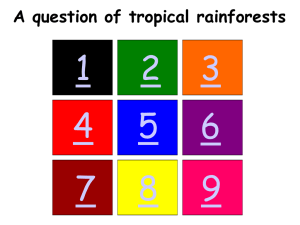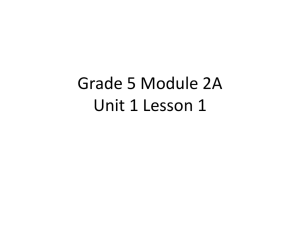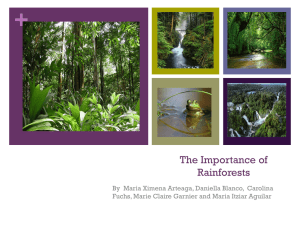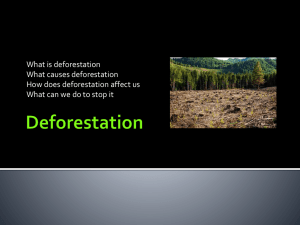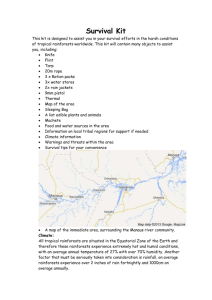Rainforest
advertisement
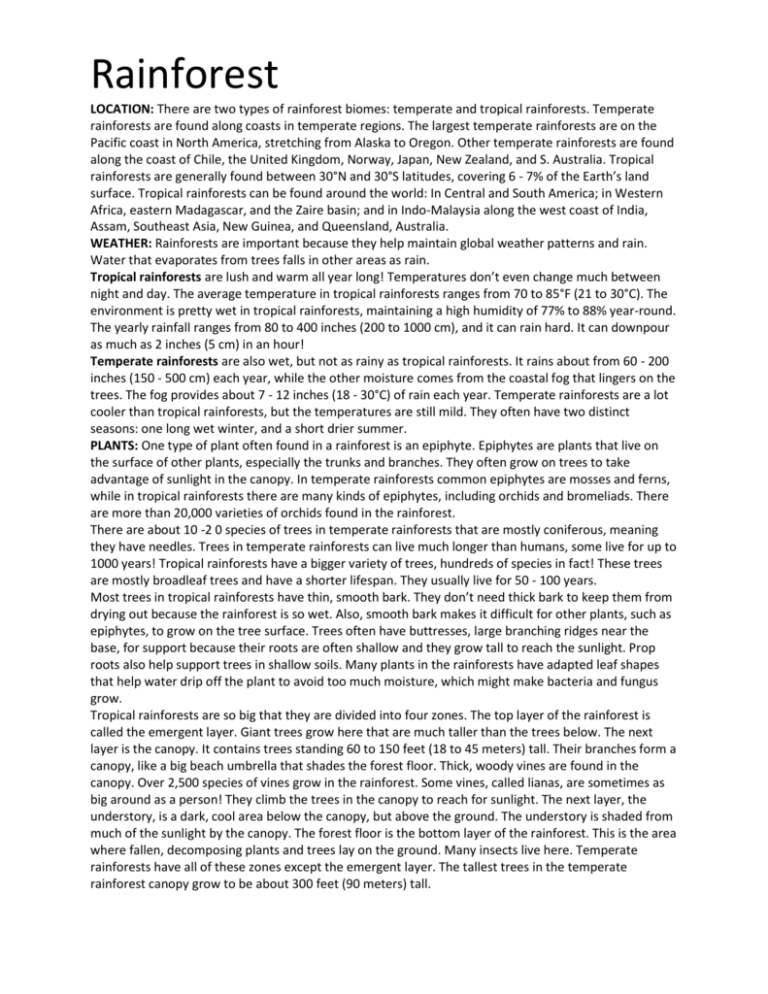
Rainforest LOCATION: There are two types of rainforest biomes: temperate and tropical rainforests. Temperate rainforests are found along coasts in temperate regions. The largest temperate rainforests are on the Pacific coast in North America, stretching from Alaska to Oregon. Other temperate rainforests are found along the coast of Chile, the United Kingdom, Norway, Japan, New Zealand, and S. Australia. Tropical rainforests are generally found between 30°N and 30°S latitudes, covering 6 - 7% of the Earth’s land surface. Tropical rainforests can be found around the world: In Central and South America; in Western Africa, eastern Madagascar, and the Zaire basin; and in Indo-Malaysia along the west coast of India, Assam, Southeast Asia, New Guinea, and Queensland, Australia. WEATHER: Rainforests are important because they help maintain global weather patterns and rain. Water that evaporates from trees falls in other areas as rain. Tropical rainforests are lush and warm all year long! Temperatures don’t even change much between night and day. The average temperature in tropical rainforests ranges from 70 to 85°F (21 to 30°C). The environment is pretty wet in tropical rainforests, maintaining a high humidity of 77% to 88% year-round. The yearly rainfall ranges from 80 to 400 inches (200 to 1000 cm), and it can rain hard. It can downpour as much as 2 inches (5 cm) in an hour! Temperate rainforests are also wet, but not as rainy as tropical rainforests. It rains about from 60 - 200 inches (150 - 500 cm) each year, while the other moisture comes from the coastal fog that lingers on the trees. The fog provides about 7 - 12 inches (18 - 30°C) of rain each year. Temperate rainforests are a lot cooler than tropical rainforests, but the temperatures are still mild. They often have two distinct seasons: one long wet winter, and a short drier summer. PLANTS: One type of plant often found in a rainforest is an epiphyte. Epiphytes are plants that live on the surface of other plants, especially the trunks and branches. They often grow on trees to take advantage of sunlight in the canopy. In temperate rainforests common epiphytes are mosses and ferns, while in tropical rainforests there are many kinds of epiphytes, including orchids and bromeliads. There are more than 20,000 varieties of orchids found in the rainforest. There are about 10 -2 0 species of trees in temperate rainforests that are mostly coniferous, meaning they have needles. Trees in temperate rainforests can live much longer than humans, some live for up to 1000 years! Tropical rainforests have a bigger variety of trees, hundreds of species in fact! These trees are mostly broadleaf trees and have a shorter lifespan. They usually live for 50 - 100 years. Most trees in tropical rainforests have thin, smooth bark. They don’t need thick bark to keep them from drying out because the rainforest is so wet. Also, smooth bark makes it difficult for other plants, such as epiphytes, to grow on the tree surface. Trees often have buttresses, large branching ridges near the base, for support because their roots are often shallow and they grow tall to reach the sunlight. Prop roots also help support trees in shallow soils. Many plants in the rainforests have adapted leaf shapes that help water drip off the plant to avoid too much moisture, which might make bacteria and fungus grow. Tropical rainforests are so big that they are divided into four zones. The top layer of the rainforest is called the emergent layer. Giant trees grow here that are much taller than the trees below. The next layer is the canopy. It contains trees standing 60 to 150 feet (18 to 45 meters) tall. Their branches form a canopy, like a big beach umbrella that shades the forest floor. Thick, woody vines are found in the canopy. Over 2,500 species of vines grow in the rainforest. Some vines, called lianas, are sometimes as big around as a person! They climb the trees in the canopy to reach for sunlight. The next layer, the understory, is a dark, cool area below the canopy, but above the ground. The understory is shaded from much of the sunlight by the canopy. The forest floor is the bottom layer of the rainforest. This is the area where fallen, decomposing plants and trees lay on the ground. Many insects live here. Temperate rainforests have all of these zones except the emergent layer. The tallest trees in the temperate rainforest canopy grow to be about 300 feet (90 meters) tall. Rainforest ANIMALS: Tropical rainforests are home to half the plant and animal species on Earth. Scientists believe that there is such a great diversity of animals in tropical rainforests because they are one of the oldest ecosystems on earth. Some forests in Southeast Asia have been around for at least 100 million years, ever since dinosaurs roamed the earth. Animals in the tropical rainforest are specially adapted to live in this unique environment. A common characteristic found among mammals, birds, reptiles and amphibians, is an adaptation to living in trees. One example is New World monkeys that have prehensile tails that curl around branches allowing the monkey to hold onto the tree with its tail! Other animals are brightly colored, sharply patterned, have loud vocalizations, and like to eat lots of fruit. Most of the animals in the tropical rainforest live in the canopy. There is so much food available up there that some animals never go down to explore the forest floor! Birds are important to rainforests because they like to eat seeds and fruit. Their droppings grow into new plants and help rainforests to survive. In turn, tropical rainforests are important to birds because they provide winter grounds as migratory destination. Parrots are not the only type of birds you will see in the rainforest. In fact, about 27% of the bird species in the world live in tropical rainforests. Insects make up the largest single group of animals that live in tropical forests. They include bright beautiful butterflies, menacing mosquitoes, camouflaged stick insects, and colossal colonies of ants. In temperate rainforests you’ll find a different set of amazing animals. Most of these animals live on, or near the forest floor where they are protected from the wind and rain by the trees above. Many birds and small mammals, such as chipmunks, like to eat seeds that fall on the forest floor. Lots of insects live in the temperate rainforest. Most of them live in tree bark, decomposing dead plant matter, or mossy areas. Birds and amphibians like to eat these insects. Some mammals in the temperate rainforest include deer and bobcats. Cougars and bobcats are the top predators in this biome.
